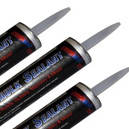How to Determine Poor Sealant and Adhesive Quality?
- 25 August 2016
- Posted by: Madhuraka
- Category: Article
 Adhesive compounds rely on a uniform state change, a fully hardened or cured structural change that’s generated by a widespread chemical reaction. Unlike a fastener, we can’t just jiggle a component and see if it’s loose. Neither can we spot a crack in a weld, for this is a wholly chemical bond. Instead, poor sealant and adhesive quality is assessed by analyzing the cured chemical compound and appraising its fundamental properties. We begin with a visual inspection.
Adhesive compounds rely on a uniform state change, a fully hardened or cured structural change that’s generated by a widespread chemical reaction. Unlike a fastener, we can’t just jiggle a component and see if it’s loose. Neither can we spot a crack in a weld, for this is a wholly chemical bond. Instead, poor sealant and adhesive quality is assessed by analyzing the cured chemical compound and appraising its fundamental properties. We begin with a visual inspection.
Visual Clues
A cloudy sealant may indicate a typical cure phase, but if the substance cures clear on one joint and then cloudy on the next, then it’s obvious that the cloudiness issue represents a problem. Opaque curing is usually a sign of moisture. But look closer, for tiny air bubbles also cause the clear veneer to dull. Either way, the uniform distribution of the transformative substrate is going to be attenuated by such effects. The environmental conditions play a big part here, so does the skill level of the installing technician. Application errors are responsible for the aforementioned bubbles as well as many aesthetical problems, including unsightly cure wrinkles.
Poor Sealant and Adhesive Quality Hides in Plain Sight
Visual cues are easy to spot, but such quality indicators aren’t always quick to present themselves, as they may only develop over time. Additionally, adhesives and sealants with questionable cure qualities may look perfectly sound, but that doesn’t mean the joint isn’t brittle or prone to shrinkage. Brittle bonds will crack, obviously, so look for fine breaks. Stress factors tear apart brittle chemical joints, so elasticity is a particularly important feature here, one that cancels brittleness and accounts for transient mechanical stresses.
Neutralizing Adhesion Failure
Expert chemical engineers buy time, durability, and reliability when they formulate a leading sealant. Adhesive compounds use this same design ethic, so bond failure is happily eliminated from bonding scenarios. Still, there’s a real need for poor sealant and adhesive quality checks, for other forces are in play. The surfaces where the joint is to be applied must be clean and part of the compounds bond catalog. In essence, the right sealant material must be chosen, but installation issues should also be accounted for, so humidity, UV radiation, and other bond compromising factors must be assessed.
Know how to determine bond failure, but also know that these prominent telltales won’t always be there to correct, so work smart by focusing on the formulated chemical compound, a substance that’s tailor-made for the selected application and quality-assured with a lifetime guarantee.

